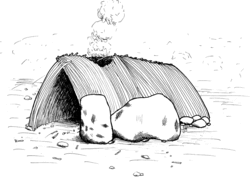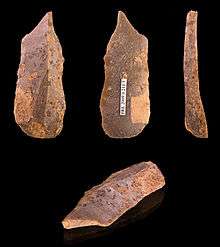Paleolithic Europe

Paleolithic Europe refers to the Paleolithic period of Europe, a prehistoric era distinguished by the development of the first stone tools and which covers roughly 99% of human technological history.[1] It extends from the introduction of stone tools by hominids 1.8 million years ago, to the introduction of agriculture and the end of the Pleistocene around 12,000 BP.[1][2][3]
It is believed that Homo erectus evolved into Homo heidelbergensis and subsequently Homo neanderthalensis in Paleolithic Europe, before being replaced by modern humans migrating out of Africa approximately 50,000 years ago. The bones of the earliest Europeans are found in Dmanisi, Georgia, and are 1.8 million years old. The oldest evidence of human occupation in Eastern Europe comes from the Kozarnika cave in Bulgaria where a single human tooth and flint artifacts have been dated to at least 1.4 million years ago. In Western Europe at Atapuerca in Spain, human remains have been found that are from 1.2 million years ago.[4][5]
Paleolithic
Lower Paleolithic : 1.8 mya - 300,000 BP

The earliest inhabitants of Europe from 1.8 million years ago used Oldowan pebble tool technology. The earliest evidence for the use of the more advanced Acheulean technology are 900,000-year-old flint hand axes found in Iberia. Notable human fossils from this most ancient period of European prehistory are Dmanisi in Georgia 1.8 mya, Kozarnika in Bulgaria 1.4 mya, Atapuerca in Spain 1.2 mya, Mauer 1 from Germany 500k, Eartham Pit, Boxgrove England 478k, Swanscombe Man from England 400k, and Tautavel Man from France 400k.
The oldest complete hunting weapons ever found anywhere in the world were discovered in a coal mine in Schoningen, Germany, in 1995 where three 380,000-year-old wooden javelins 6-7.5 feet long were unearthed.[6]
Middle Paleolithic : 300,000 BP - 50,000 BP
Eventually these European Homo erectus evolved through a series of intermediate speciations including Homo antecessor and Homo heidelbergensis into the species Homo neanderthalensis (since c. 200,000 BP) associated with the Mousterian technologies. Early Homo sapiens also participated in this tool-making technique for a long time and they may have first settled Europe while this Mid-Paleolithic technique was still in use, though the issue is still unclear.
A possible flute from the Divje Babe I cave reveals that the Middle Paleolithic Neanderthal inhabitants of Europe may have made and used musical instruments.[7]
Upper Paleolithic : 50,000 BP - 10,000 BP
Ancient Upper Paleolithic
Modern human remains dating to 43-45,000 years ago have been discovered in Italy at Grotta di Fumane and Grotta del Cavallo[8] and in Britain.[9] The bearers of most or all Upper Paleolithic technologies were H. sapiens. Some locally developed transitional cultures (Szletian in Central Europe and Chatelperronian in the Southwest) use clearly Upper Paleolithic technologies at very early dates and there are doubts about who were their carriers: H. sapiens, Neanderthal or the interbred population.
Nevertheless, the definitive advance of these technologies is made by the Aurignacian culture. The origins of this culture can be located in what is now Bulgaria (proto-Aurignacian) and Hungary (first full Aurignacian). By 35,000 BCE, the Aurignacian culture and its technology had extended through most of Europe. The last Neanderthals seem to have been forced to retreat during this process to the southern half of the Iberian Peninsula.
The first works of art appear during this phase.
Middle Upper Paleolithic

Around 32,000 BCE, the Gravettian culture appears in the Crimean Mountains (southern Ukraine).[10][11] Around 22,000 BCE, the Solutrean and Gravettian cultures reach the southwestern region of Europe. The Gravettian technology/culture has been theorized to have come with migrations of people from the Middle East, Anatolia, and the Balkans. The cultures might be linked with the transitional cultures mentioned before, because their techniques have some similarities and are both very different from Aurignacian ones but this issue is thus far very obscure. The Gravettian soon disappears from southwestern Europe, with the notable exception of the Mediterranean coasts of Iberia. The Gravettian culture also appears in the Caucasus and the Zagros mountains.
The Solutrean culture, extended from northern Spain to SE France, includes not only an advanced stone technology but also the first significant development of cave painting, the use of the needle and possibly that of the bow and arrow.
The more widespread Gravettian culture is no less advanced, at least in artistic terms: sculpture (mainly venuses) is the most outstanding form of creative expression of these peoples.
Late Upper Paleolithic
Around 17,000 BCE, Europe witnesses the appearance of a new culture, known as Magdalenian, possibly rooted in the old Aurignacian one. This culture soon supersedes the Solutrean area and also the Gravetian of Central Europe. However, in Mediterranean Iberia, Italy and Eastern Europe, epi-Gravettian cultures continue evolving locally.
With the Magdalenian culture, Paleolithic development in Europe reaches its peak and this is reflected in the advanced art, owing to the previous traditions of painting in the West and sculpture in Central Europe.
Epipaleolithic
.jpg)
Around 10,500 BCE, the Würm Glacial age ends. Slowly, through the following millennia, temperatures and sea levels rise, changing the environment of prehistoric people. Nevertheless, Magdalenian culture persists until circa 8000 BCE, when it quickly evolves into two microlithist cultures: Azilian, in Spain and southern France, and Sauveterrian, in northern France and Central Europe. Though there are some differences, both cultures share several traits: the creation of very small stone tools called microliths and the scarcity of figurative art, which seems to have vanished almost completely, being replaced by abstract decoration of tools.
In the late phase of this Epipaleolithic period, the Sauveterrean culture evolves into the so-called Tardenoisian and influences strongly its southern neighbour, clearly replacing it in Mediterranean Spain and Portugal.
The recession of the glaciers allows human colonization in Northern Europe for the first time. The Maglemosian culture, derived from the Sauveterre-Tardenois culture but with a strong personality, colonizes Denmark and the nearby regions, including parts of Britain.
See also
References
- 1 2 Nicholas Toth & Kathy Schick (2007). Handbook of Paleoanthropology. Springer Berlin Heidelberg. p. 1963. ISBN 978-3-540-32474-4.
- ↑ Grolier Incorporated (1989). The Encyclopedia Americana. University of Michigan: Grolier Incorporated. p. 542. ISBN 0-7172-0120-1.
- ↑ "Stone Age," Microsoft Encarta Online Encyclopedia 2007 Contributed by Kathy Schick, B.A., M.A., Ph.D. and Nicholas Toth, B.A., M.A., Ph.D.
- ↑ "'Fossil find is oldest European yet'". Nature News. 2008-03-26.
- ↑ Trinkaus, E; Moldovan, O; Milota, S; Bîlgăr, A; Sarcina, L; Athreya, S; Bailey, Se; Rodrigo, R; Mircea, G; Higham, T; Ramsey, Cb; Van, Der, Plicht, J; Moldovan; Milota; Bîlgar; Sarcina; Athreya; Bailey; Rodrigo; Mircea; Higham; Bronk Ramsey; Van Der Plicht (Sep 2003). "An early modern human from the Peştera cu Oase, Romania" (Free full text). Proceedings of the National Academy of Sciences of the United States of America. 100 (20): 11231–6. Bibcode:2003PNAS..10011231T. doi:10.1073/pnas.2035108100. ISSN 0027-8424. PMC 208740
 . PMID 14504393.
. PMID 14504393. - ↑ http://archive.archaeology.org/9705/newsbriefs/spears.html
- ↑ Nelson, D.E., Radiocarbon dating of bone and charcoal from Divje babe I cave, cited by Morley, p. 47
- ↑ Benazzi, S.; Douka, K.; Fornai, C.; Bauer, C. C.; Kullmer, O.; Svoboda, J. Í.; Pap, I.; Mallegni, F.; Bayle, P.; Coquerelle, M.; Condemi, S.; Ronchitelli, A.; Harvati, K.; Weber, G. W. (2011). "Early dispersal of modern humans in Europe and implications for Neanderthal behaviour". Nature. 479 (7374): 525–8. doi:10.1038/nature10617. PMID 22048311.
- ↑ Higham, T.; Compton, T.; Stringer, C.; Jacobi, R.; Shapiro, B.; Trinkaus, E.; Chandler, B.; Gröning, F.; Collins, C.; Hillson, S.; o’Higgins, P.; Fitzgerald, C.; Fagan, M. (2011). "The earliest evidence for anatomically modern humans in northwestern Europe". Nature. 479 (7374): 521–4. doi:10.1038/nature10484. PMID 22048314.
- ↑ Prat, Sandrine; Péan, Stéphane C.; Crépin, Laurent; Drucker, Dorothée G.; Puaud, Simon J.; Valladas, Hélène; Lázničková-Galetová, Martina; van der Plicht, Johannes; Yanevich, Alexander (17 June 2011). "The Oldest Anatomically Modern Humans from Far Southeast Europe: Direct Dating, Culture and Behavior". plosone. Retrieved 21 June 2011.
- ↑ Carpenter, Jennifer (20 June 2011). "Early human fossils unearthed in Ukraine". BBC. Retrieved 21 June 2011.
External links
- Links to Paleolithic sanctuaries in France: